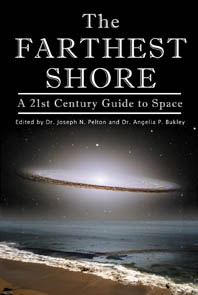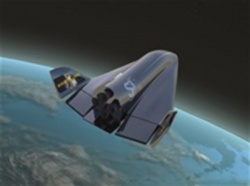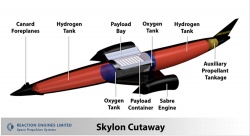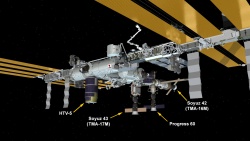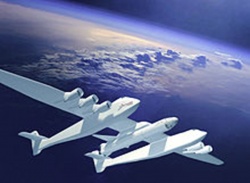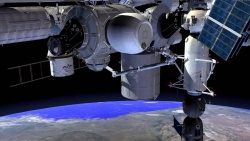The Farthest Shore – Chapter Fourteen The New Commercial Launch Services
From The Space Library
Chapter Fourteen The New Commercial Launch Services and Private Space Station
Chris Welch, Peter Marshall and Joseph Pelton
14.1 Introduction
Over the last decade, the “New Space” industry has served to galvanize and inspire a host of new space activities, new space systems and new ways of doing business in space. Today, the space sector media features news of initiatives related to space mining and extraterrestrial resource extraction; space materials processing and manufacturing; on-orbit servicing, refueling, and refurbishing; and even the transformation of defunct spacecraft into new space systems. There are also new and focused undertakings with the intention of creating space-based solar power systems and commercial space stations. There is even thought of space colonization. None of this would be possible, however, without significant efforts to create new types of commercial launch capability, all with the ultimate aim of reducing the cost of launching payloads.
There are a number of events that have contributed to this, but two are considered to have particular historical significance. These are the creation of the XPRIZE Foundation in 1996 and the launch of the world’s first space tourism company, Space Adventures Ltd., in 1997.
Although it has since diversified into other areas, the original purpose of the XPRIZE was to stimulate the creation of privately-operated space-planes that could take space tourists into space (if not all the way to orbit) in large numbers, so laying the foundations for a new commercial space industry and allowing, ultimately, many thousands of people to see Earth from space. Space Adventures, on the other hand, sought to demonstrate that orbital space tourism was possible and provided extended periods of time in space for those rich enough to pay millions of dollars to do so.
Peter Diamandis’ dream was to make possible the opportunity for tens of thousands of “citizen astronauts” to see Earth as a spherical spaceship flying in the cosmos and thus with entirely new vision.[1]
The initial part of this chapter explains how these two different, yet connected, approaches to space commerce have triggered a wide range of innovations in commercial space transportation that appear ready to transform our capabilities over the coming decades. Overall this chapter is broken down in a number of sections that relate the development of all these new space transportation technologies, industries and systems as they have evolved, even though there has been a considerable amount of overlap during the past twenty years.
14. 2 The XPRIZE and Spaceplane
In 1996 Peter Diamandis, one of the founders of the International Space University and the ZeroG company and currently CEO of Planetary Resources Inc., started a campaign to create a challenge fund to spur the development of reusable space vehicles that could travel to space and back. Diamandis’ chutzpah and determination are well illustrated by one of his favorite sayings; “The meek shall inherit the Earth; the rest of us will go to Mars.”
The XPRIZE was launched by Diamandis in May 1996 in his typical showman fashion when he announced his intention to create a $10 million incentive prize to reward the first private effort to build a space vehicle and successfully fly it into space—i.e. above 100km altitude—with pilot and crew and to do this safely twice in a period of two weeks.[2] Diamandis was building on a tradition of incentive prizes in technology, especially in the field of aviation in the early 20th century. Perhaps the most well-known of these is the Orteig Prize won by Charles Lindbergh in May 1927 for his solo flight over the Atlantic.[3] Others, such as the Collier prize for the outstanding annual contribution in aviation, and the Schneider Trophy also led to many advances.[4]
Although progress was slow initially, Diamandis successfully convinced the Prodea Company - owned by the Ansari Family of Plano, Texas - to finance this prize. As is often the case with Diamandis, the actual arrangement was unconventional. What was agreed with the Ansari family (after whom the prize would be named) would purchase an insurance pol-icy for $1 million. The insurance company would payout $10 million should the goal be achieved by a 2004 deadline. Experts consulted by the insurance company provided reasonable assurance that the timetable was too short for success and that the policy was easy money.[5]
Despite this view, around 20 teams signed on to try to meet the challenge. One of the teams was backed by Paul Allen, one of the founders of Microsoft and led by legendary aircraft designer Burt Rutan. Rutan has designed many lightweight, composite aircraft including the Voyager, which flew non-stop around the world without refueling in 1986. Rutan’s expertise with composite materials and his experience with wide-winged, double-fuselage aircraft were essential to creating the lightweight Space-ShipOne and its White Knight carrier aircraft that in late September and early October 2004 that won the Ansari XPRIZE.
Although Rutan claimed the $10 million payout, this did not recoup developments cost - Paul Allen is reported to have invested some $25 million in the program. Other estimates are much higher still.[6]
Since the Ansari XPRIZE, there have been two more space-related XPRIZEs. Between 2006 and 2009 the Northrop Grumman Lunar Lander XCHALLENGE was a competition co-hosted with NASA to design build and fly small rocket systems suitable for landing on the Moon. It was won in 2009 by Masten Space Systems.
Secondly, and still under way at the time of writing, the Google Lunar XPRIZE was launched in 2007 to stimulate private robotic missions to the Moon. The $20 million main prize will be won by the first team to land a spacecraft on the Moon, travel at least 500 meters across the surface and send back high definition video footage of the landscape. There are additional special bonus prizes of $5 million for imaging human-made objects on the Moon (e.g. the Apollo 11 lunar lander) or surviving the lunar night. Five teams of the 16 registered teams have specific plans to launch their moon missions during 2017 in their efforts to win the prize. These teams are SpaceIL, Moon Express, Synergy Moon, Team Indus, and Hakuto of Japan.[7]
XPRIZE is not alone in its efforts to promote new space ventures and achievements. NASA has also held a number of competitions to encourage commercial companies to develop new and improved landing systems on the Moon or other celestial bodies and even to develop the technology that would be needed to design, construct and deploy a space elevator such as robotic climbers, tethers, etc.[8]In addition, NASA has provided a number of prize money awards for student research projects into topics such as 3D printers that could print out lunar habitats, etc.[9]
In addition, in 2004 space entrepreneur Robert Bigelow (who is developing inflatable structures in space that could serve as a private space habitat) announced America’s Space Prize. This was a $50 million prize for the private launch company that could launcha5-person reusable crew capsule to low Earth orbit and repeat the task within 60 days. This incentive prize was not nearly as popular as others because of its high degree of dif-ficult and it expired in 2010 without any attempts being made to win it. Bigelow, who made his billions as the head of the American Budget Suites hotel chain, has nevertheless forged ahead with his very real and earnest plans to deploy commercial space habitats and we will return to his exploits later in this chapter.[10]
When the SpaceShipOne successfully landed at Mojave in California on 4 October, 2004 (on the anniversary of the flight of Sputnik in 1957) and claimed the Ansari XPRIZE, many felt it signaled the start of a new era of commercial development in space. There was not only a new sense of commercial space enthusiasm, but also a feeling that this represented the passing of a torch of space activities from space agencies to space entrepreneurs—at least as far as activities in low Earth orbit were concerned. A symbol of this that was much noted on this occasion was the handcrafted sign that read “SpaceShipOne—NASA Zero”. Clearly, the successful two back-to-back flights of SpaceShipOne were taken to mean that something new was afoot at the cusp between the old and new centuries.[11]
The dream that was emerging was the idea of transforming space flight from something that only a handful of professional astronauts could do at enormous cost in the context of space agency activities into something that the general populace could one day experience. It had taken only a little over twenty years between the first flight by the Wright Brothers at Kitty Hawk to the idea of commercial air travel. Now, nearly five decades after Sputnik, people were beginning to think seriously about ideas such as space tourism flights to the dark sky of space by ‘citizen astronauts’ and about new and lower cost vehicles to launch satellites into space. Others began thinking about hypersonic vehicles that could transport passengers from London to Sydney or from New York to Tokyo in a few hours. Yet others began thinking about what new things they could do in space if the cost of launch services came down. One particular new area of endeavor that came from this “new space” revolution was sub-orbital space tourism – the development of reusable space vehicles intended to fly in a parabolic trajectory, taking them above 100 km. This concept included the idea of flight training, special briefings and ultimately offering passengers a view of Earth from the dark sky of outer space and a few minutes of weightlessness before descending back to Earth.
Perhaps the most well-known sub-orbital space tourism project is that which came from the team that won the Ansari PRIZE. Founded in 2005 by Burt Rutan and Sir Richard Branson, the CEO of the Virgin corporate empire, The Spaceship Company (TSC) was created to design and manufacture the vehicles required by Branson’s Virgin Galactic (VG) sub-orbital space tourism company which had been founded the year before.
TSC was to build the new SpaceShipTwo vehicles that would be carried aloft by White Knight 2 carrier aircraft which, Brandon hoped and expected, would allow him to be the first to offer space tourism flights. After a strong start, VG collected deposits from more than600 expectant space tourists keen to fly into space, despite the $200,000 ticket price. Progress proved to be uneven, however, and a number of problems were encountered. The two most notable were the deaths of the three Scaled Composite employees in 2007 when an oxidizer tank detonated during a propulsion system ground test and, in 2014 when the loss of SpaceShipTwo VSS Enterprise during a flight test conducted on Halloween October 31 2017. This tragic accident s resulted in injuries to the pilot and the death of the co-pilot.
The U.S. National Transportation Safety Board’s final conclusion was that the accident was due to pilot error, but also criticized the designers for not including fail-safe systems that would have prevented the error. This crash clearly set back the development of VG’s space tourism vehicle and impacted the market for such space adventures overall.[12]
Clearly, the development of a reliable, reusable space transportation system has proved to be much more difficult than some people originally expected. The U.S. Congress passed a space transportation act that first provided funding and oversight by the Federal Aviation Authority(FAA) of experimental spaceplane flights through 2012. When spaceplanes were not flying by 2012, Congress then extended the authorization for FAA oversight to 2015.Most recently, Congress has recognized the development of such vehicles is not a short-term proposition and so extended FAA oversight of experimental spaceplanes with case-by-case licensing through to 2025.[13]
In 2005, Courtney Stadd, who has served many years at NASA as well as at the U.S. Department of Transportation, made the following comments related to the development spacecraft that can consistently fly with short turn-around to over 100km in altitude and not unduly endanger the crew and its passengers:
“Space entrepreneurs still tend to be seduced by the tendency to mistake technical possibility for market opportunity. Nonetheless, I feel that, by and large, today’s entrepreneurs represent a particularly sophisticated and seasoned group of business managers who stand a better chance of navigating the many daunting technical and market challenges associated with the new commercial space industry sector. Although it is still a work in progress, the good news is that the US government is doing a better job of fostering a more stable and predictable regulatory and policy climate for space entrepreneurs”.[14]
In the decade and a half since the Ansari XPRIZE was won, a quarter of a billion dollars has been spent to build and open Spaceport America in the high desert of New Mexico to support Virgin Galactic (VG) flights. In addition, over a dozen other space ports have been created elsewhere and a huge amount of money has been invested to perfect the SpaceShipTwo vehicle. However, despite investments that may total over $1 billion dollars worldwide to develop spaceplanes and spaceports to fly “space tourists” into space, the date for actual flights by paying customers is still to be firmly set.
The drive to deliver passengers to space on sub-orbital flights, has slowed in the pursuit of greater safety. The expected progress has been much slower than expected because space travel is hard and safe space travel is harder still. Although no space tourists have yet flown to space, the date when “citizen astronauts” will successful climb to outer space and back now seems imminent. Since VG’s plans to use their system to also launch small satellites their overall business plan has been strengthened. A new vehicle, LauncherOne, is thus being developed. This will be air-launched from a Boeing 737 carrier aircraft and will be able to launch payloads of around 200 kg into Low Earth Orbit. In 2015 VG contracted with OneWeb for thirty-nine launches for its satellite constellation with an option for up to one hundred additional launches. Virgin Galactic anticipates that revenues from this type of spacecraft launch by its Launcher One vehicle can provide a significant amount of revenue. For this reason, in early 2017 VG’s small satellite launching business was transferred to a brand-new company, Virgin Orbit.[15]
Others hope to use similar business models. Rocket Labs of New Zealand have contracted to provide a launcher to Moon Express for a small satellite launch to the Moon in late 2017. Firefly Launch System of Cedar Park, Texas also sought to develop a small cubesat class satellite launcher, but has now gone bankrupt.[16] NASA has sought to encourage such new developments by awarding three small venture class contracts for cubesat launches.[17]
As Virgin has struggled to develop its space launch systems, others have also taken up the challenge. The U.S. firm XCOR Aerospace has, for over a decade, also been trying to develop its own reusable spaceplane – the Lynx rocket plane. As early as 2012, more than 150 Lynx flights had been presold to prospective space tourists. The Lynx Mark 1 was intended to fly 61 kilometers into space with a pilot and a single paying passenger. This vehicle was to be followed by the XCOR Mark 2 that was expected to fly to the 100-kilometer altitude.[18] However, in 2016 XCOR laid off a significant number of its employees and put the Lynx project on indefinite hold while it focused on development of a new cryogenic rocket engine.
Another now unsuccessful attempt to create a space tourism reusable sub-orbital vehicle was that of Swiss Space Systems (S3). Founded in 2013, S3 was attempting to develop its SOAR spaceplane. This was intended to be air launched from an Airbus A300 aircraft and to operate out to a variety of global locations. Again, there were also plans to use it as a plat-form for the launch of small satellites, as well as providing point to point intercontinental flights. However, after surviving some significant financial difficulties, S3 has declared bankruptcy as of late in 2016.[19](See Figure 14.1).
Despite these setbacks there are still some four-dozen small satellite launcher companies around the world seeking to prove that they can succeed where others have failed.
Although not connected directly with space tourism, discussion of proposed commercial spaceplanes would not be complete without mentioning Skylon, which is a proposed single-stage-to-orbit spaceplane being developed by the British company Reaction Engines Ltd (REL). Skylon would be a robotic, liquid hydrogen-fueled vehicle that would carry a payload of up to 15,000 kg to Low Earth Orbit before returning to Earth again. Key to Skylon is the SABRE hypersonic precooled hybrid air-breathing rocket engine, originally conceived by REL’s founder Alan Bond in 1989. After many years of painstaking technical development, a fully integrated SABRE engine test is planned for 2020.[20](See Figure 14.2).
These represent only some of the commercial and civil projects that have been undertaken. The U.S. Defense Advanced Projects Research Agency’s (DARPA) XS-1 (Experimental Spaceplane) vehicle is currently expected to fly in 2019. XS-1 is intended to be a robotically-controlled, reusable spaceplane, designed to deploy 1400 kg satellites in Low Earth Orbit at a cost that is significantly below that of any current launching system. This project has the following stated mission:
“The objective of the Experimental Spaceplane XS-1 program is to demonstrate the technology needed to fabricate and fly a reusable aircraft to the edge of space. The XS-1 will be capable of deploying a small expendable upper stage to launch a 3,000-pound spacecraft to Earth orbit at a cost of $5M, ten times less than today’s launch systems. A key program objective is to fly 10 times in 10 days to demonstrate “aircraft-like” operability, cost efficiency and reliability. Key anticipated characteristics of the XS-1 aircraft include a physical size and dry weight typical of today’s business jets.”[21]
If this capability is developed successfully by 2019, the XS-1 will have a much greater launch capacity than any of the commercial launch systems using spaceplanes now being planned. Since military systems are typically shrouded in secrecy, it is not clear what capabilities now exist in terms of military spaceplanes but there are almost certainly additional capabilities under development under military funding around the world.
In a final note on spaceplanes, it should be noted that there is a further type of development that does not involve spaceplanes per se, but are focused on hypersonic terrestrial transport. The objective of these is not take tourists to space, but instead to ferry people around the world at much higher speeds.
The heritage of the research and development in this area are vehicles that first began to be developed in the 1960s and 1970s that were first called scramjets – supersonic combusting ramjets. The scramjet concept was to develop lighter weight and more efficient vehicles that would use air from the atmosphere to oxidize the fuel rather than having to carry something like liquid oxygen on board the craft for this purpose. Other engine concepts that attempt to do this include liquid air cycle engines (LACE) and the REL’s SABRE engine mentioned above. With such systems, it is possible to conceive a new type of air transport that could fly stratospheric transoceanic paths at supersonic speeds and which would represent the next generation of transcontinental transport beyond the Concorde SST (this is an alternative application for a SABRE-derived engine called Scimitar which was been examined in European Union-funded LAPCAT studies).
NASA, the Japanese space agency JAXA, and ESA all have active research and development programs looking at hypersonic craft. There are also commercial development programs by companies such as Lockheed Martin, Boeing, AirBus and QSST (for Quiet Supersonic Transport) that are exploring jet and rocket transport systems that would fly at Mach 2 to Mach 6 speeds and would typically be designed to fly at subsonic speeds to high altitudes and then reach supersonic or hypersonic speeds in the stratosphere with high arcing flights peaking at around 80 kilometers. As noted, REL in the United Kingdom and Airbus in Europe have active research programs in Europe with support from ESA, while JAXA is testing model vehicles using liquid hydrogen and liquid oxygen fueling systems. In some cases, these programs are linked to spaceplane development efforts and in other cases they are not.
Developments in this area seem to pose a classic set of policy questions for the different national and international agencies that address a particular part of the many issues raised by such new technological developments. For instance, there is the issue of passenger safety which presumably is a likely future concern of the International Civil Aviation Organization (ICAO). There is the issue of radiation exposure and health issues that is presumably something that the World Health Organization (WHO) would address. There is the issue of frequency use and allocation for radio communications that is something that the International Telecommunication Union (ITU) would address. Then there is the issue of stratospheric pollution which would be the concern of the UN Environmental Programme (UNEP) and the World Meteorological Organization (WMO). There is great difficulty in getting such issues addressed in a coherent and holistic way since there is no World Space Organization. The UN Committee on the Peaceful Uses of Outer Space (COPUOS) and the UN Office of Outer Space Affairs (UN-OOSA) do not have the staff nor the mandate to oversee all of these diverse issues. This demonstrates clearly the difficulty of formulating policy and creating timely regulation in the field of space.
14.3 Space Adventures and the International Space Station
There was a student just out of college studies who was hired by NASA as an intern. This young man was terribly excited about the promise of outer space, but he was also impatient and intent on making things happen quickly. It turns out that this is a trait of many of the people who have pushed, jerked, hammered, coerced and even financed the unfolding of “new space’ launch capabilities over the past two decades.
This man was named Eric Anderson and in 1997 he, along with his erstwhile partners Diamandis and McDowell, founded a company called “Space Adventures”. The ambition was to create a company that would allow civilians to fly into space and especially to the International Space Station (ISS) for a stay in orbit. The first challenge was to raise the money to found his company. This took a while. One day he had an appointment with a man named Dennis Tito. Anderson went through his routine and at the end Tito said, “I’m sorry Eric, but as an investor it’s no dice. But if you can arrange for me to get a flight to the International Space Station for a stay, I will be willing to pay up to $20 million to make that happen.” This was the start of Space Adventures for real. Anderson proceeded to meet with officials from the Russian space agency Roscosmos in Star City, outside of Moscow, and put together a deal which provided for Tito to travel to Star City and be trained as a cosmonaut for seven months and undertake a week-long trip to the ISS in 2001.
NASA, as Roscosmos’ partner in the building and manning of the ISS, were unhappy about a “civilian” going on board the space station and replacing a highly-trained astronaut/cosmonaut. After some negotiation, though, this is what happened and Tito managed admirably well in carrying out his assigned tasks. The money that Tito paid to Space Adventures was sufficient to compensate Roscosmos for the rides on the Soyuz vehicle, engage in cosmonaut training and to capitalize the Space Adventures firm that was set up in Tysons Corner, Virginia near to Washington, D.C. Since then Anderson has built up Space Adventures into a thriving firm that has arranged to fly a half dozen more “private spaceflight participants” to the ISS for extended stays. The “fare” for the last visit had escalated to $35 million.[22]
The citizen astronauts that have now travelled to the space station include more than a half dozen people. First, as noted above, was Dennis Tito, the computer scientist and manager of a multi-billion investment fund (2001). Next came South African computer entrepreneur and multi-millionaire Mark Shuttleworth (2002), Gregory Olsen, manufacturer of high-sensitivity cameras (2003), Anousheh Ansari, who along with her brother also provided the innovative financing for the first XPRIZE award mentioned in the previous section of this chapter (2006).
Then came the Microsoft founding engineer and founder of International Software, Charles Simonyi. Remarkably he was the “citizen astronaut who at tremendous expense travelled to the ISS in 2007 and again in 2009. In between Simonyi’s jaunts to space came video game developer and entrepreneur Richard Garriott, the son of 1970s NASA astronaut Owen Garriott, who also traveled to the ISS. He was then followed in 2009 by Cirque du Soleil founder Guy Laliberte, who became not only the first Canadian space tourist, but also the first clown in space. All of these paying customers contracted their trip to the ISS with Space Adventures and travelled there on Russian launchers and in Soyuz capsules. (See Figure 14.3).
The company reports that it has sold more than $300 million worth of Space Adventure activities. It has broadened its portfolio of offerings to include a spacewalk option for an additional $20 million and that perhaps for $100 million it could offer a fly-by of the Moon. So far, no clients have signed up for these sky-high rides. because the end of the US Space Shuttle program has meant that the Russian Soyuz launches are the only way for the professional astronauts from all the ISS partner countries to travel to and from the station. It was announced that the noted soprano Sarah Brightman was going to be the second female citizen astronaut to fly to the ISS. Her training began in 2013 for an expected 2015 flight at a reported price of some $35 million. However, this arrangement was abruptly cancelled for reasons that were not explained. Possibly it was connected to her acceptance of the role as UNESCO Ambassador of Peace and her potential absence from professional singing that the seven months of astronaut training in Russia were typically required of those going to the ISS via the Soyuz vehicle.
Space Adventures also has a range of lower cost offerings in addition to his multi-million-dollar space travel expeditions. Space Adventures can thus also arrange for trips to Star City for cosmonaut training sessions, or very high altitude elliptical trajectory rides as a co-pilot in a Russian Fox-bat jet which cost in the range of $10-20 thousand. Space Adventures can also provide weightless experiences, as well. These can be either on a Russian Ilyushin 76 cargo plane or a Boeing727 jet operated by the Zero-G Corporation. These specially equipped planes fly a series of parabolic maneuvers which give passengers the opportunity to experience true weightlessness for 20 seconds at a time during each parabola. One can book an entire flight for 37 passengers for $165,000. These flights reportedly are grossing over $100 million annually.[23]
14.4 New commercial launch systems and reusable launch vehicles
As the enthusiasm for developing commercial spaceplanes and space tourism developed, other people were starting to think about commercial launch vehicles that could launch large satellites, even to Low Earth Orbit (LEO), Geostationary orbit (GEO) orbit and beyond. One especially notable figure is billionaire Elon Musk. Musk, who had made his first fortune as one of the founders of PayPal, decided to pursue his aims in this area. In 2002, he launched the Space Exploration Technologies Corporation – usually known as ‘SpaceX’. As with all of those that have made the “New Space” revolution possible, Musk’s initial goal was audacious. He wanted not only to bring down the cost of launching into space by an order of magnitude in order to make a wide range of new space activities possible, but eventually to make possible viable travel to Mars so that it could be eventually colonized. Musk’s long-term goal is to provide the transportation infrastructure that will allow one million people to travel to Mars and establish a colony there.[24]
To this end, Musk and SpaceX have made remarkable progress to date, showing what can be done with intense focus, innovative engineering, and an infusion of capital. SpaceX first developed the Falcon 1 launcher, followed by the Falcon 9, and the Dragon space capsule that is being used to resupply the International Space Station. SpaceX has demonstrated the launch, recovery and reuse of its first stages and is planning to further develop system reusability to bring down cost. An upgraded Falcon 9 and crewed Dragon capsule are being developed to provide astronaut access to the ISS under NASA funding (and in competition with Boeing and Sierra Nevada). Furthermore, the company is now developing the Falcon 9 Heavy, along with the Red Dragon capsule which Musk intends to send to Mars. For a start from scratch, this is a very impressive display of space innovation and achievement in only a decade and a half. But Musk and his Space X efforts, aimed at creating better and more cost effective commercial launch vehicles, are not alone.
The Sierra Nevada Corporation (SNC) has been developing its Dream Chaser mini-space shuttle that it hoped would carry astronauts to and from the ISS under the NASA Commercial Crew Integrated Capability (CCi-CAP) Program. The SpaceX Crew Dragon capsule plus the Boeing CST100 Starliner capsule were also selected by NASA but these systems involved launchers and capsule returns. Dream Chaser, which was also eventually selected, involves a different design concept in that this craft would fly and return to land as a spaceplane vehicle. This small spaceplane uses environmentally-friendly Ethanol fuel evolved from earlier designs that can be traced back to NASA’s HL-10 and HL-20 lifting bodies as well as the Soviet Mikoyan-Gurevich MiG-105 military spaceplane concept. Other “heritage” vehicles include the US DynaSoar project and even Jim Benson’s designs for a spaceplane developed at SpaceDev and the Benson Space Company that were predecessors of SNC. The motor, however, no longer use the hybrid propulsion system that Benson originally designed that involved burning neoprene with nitrous oxide as the oxidizer.
The current design of the Dream Chaser allows it to be launched on an Atlas V, an Ariane 5, or a Falcon 9 Heavy launcher. Thus, while Dream Chaser started out as a highly entrepreneurial effort promoted by Benson as a spaceplane venture, it has now morphed into a small reusable manned space vehicle that rides as the top stage of a very large launch vehicle.[25](See Figure 14.4).
Another entrepreneur who has sought to develop new private launch capabilities is Amazon.com founder Jeff Bezos. Bezos’ Blue Origin company has developed its New Shepard booster and capsule and demonstrated repeated suborbital flights using the same vehicle with crewed flights being planned for 2018. The company motto is ‘Gradatim Ferociter’ or “Step-by-step, ferociously” and Blue Origin’s ambition is to develop reliable rocket systems that are increasingly more capable and also reusable to make them much more cost efficient.
The initial part of Blue Origin’s plan is to build rocket engines of greater and greater power, not only for themselves but also to supply them to other companies, for example United Launch Alliance. In 2016, Blue Origin announced its plans for its own orbital space launcher, the New Glenn, which it says will launch before 2020 and, like SpaceX Falcon 9, will have a land-able, re-usable first stage.
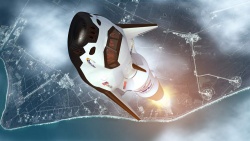
It is clear that Bezos’ Blue Origin and Musk’s SpaceX are the main leaders amongst new commercial launcher companies developing reusable rocket systems intended to significantly reduce launch costs.[26]
Currently, SpaceX is ahead of Blue Origin in terms of developing larger thrust launcher vehicles that have launched orbital payloads. Nevertheless, Blue Origin appears to be catching up with a series of more and more capable sub-orbital launches that have allowed the New Shepherd vertical launcher to return and touch down at the launch site reliably.
A final dimension to this narrative on efforts to develop new commercial launcher capabilities involves Microsoft founder Paul Allen and his Stratolaunch Systems effort. A subsidiary of Allen’s Vulcan Corporation, the object of Stratolaunch Systems is not to develop better, more reliable or more cost-efficient launch vehicles, but rather to develop more cost-efficient launch operations for these new rocket systems. Allen started from the premise, developed by Burt Rutan, that the most efficient launch operation is to let a rocket release from a high-altitude carrier plane. Allen’s Stratolaunch is a super carrier plane that is powered by six 747 engines and is thus able to carry a very large launch rocket to high altitude.[27] (See Figure 14.4).
Historically, Allen was teamed with both Space X and Rutan’s Scaled Composites, but the former dropped out and was replaced by Orbital ATK. Currently one of the options under consideration for the Dream Chaser launch arrangements to carry astronauts to the ISS would involve an air release from Stratolaunch. Clearly such an air launch from Stratolaunch would give a gravitation and velocity assist to the launch. It also eliminates the need for expensive launch pad infrastructure as well, particularly since the Dream Chaser is designed to land at a conventional airport at touchdown. (See Figure 14.5).
The advent of “new space” entrepreneurs has clearly given impetus to rapid new development of commercial space systems and especially for improved and lower cost launch capabilities. It seems not to be accidental that many of the key players who have made all of this rapid innovation such as Paul Allen, Elon Musk, Sir Richard Branson, and Jeff Bezos are not only highly entrepreneurial billionaires, but are proven innovators who are well experienced at starting entirely new enterprises.
With all of these new space ventures and efforts to create new launch systems, there has been a good deal of discussion about the use of air planes, jets and supersonic jets, spaceplanes and rockets to launch systems into orbit. It is important to note that when it comes to the thrust and power required to operate such vehicles, these craft are significantly different in terms of the basic physics involved. The following chart is useful in distin-guishing between the thrust, specific energy, velocity and altitudes that these various craft require to operate successfully. A spaceplane—that is actually a rocket--requires on the order of 20 times more specific energy than a jet to achieve its mission. A rocket that is able to boost itself and a satellite or craft or capsule into orbit requires on the order of 25 times more specific energy than a spaceplane or nearly 500 times more specific energy than a jet. The bottom line is that rocket science does involve a much greater amount of thrust than aviation science. Moving up the ladder from airplane, to jet, to spaceplane, to rocket launcher involves a much steeper climb each step of the way.
14.5 Private Space Stations and the Longer-Term Future
Ultimately, there is the question of “so what?” when it comes to developing better and better rockets. Who cares that we can develop rockets that can do more for less? In the end, there is the need to explain what new opportunities are opened up with these new launch capabilities. And the new horizons are both amazing and quite diverse. New ways to access space are lower in cost and safer, open up a wide spectrum of practical applications, new business opportunities, and scientific possibilities. This final section recaps just some of the new opportunities and notes that the future of space transportation involves more than just better rocket systems.
14.5.1 Space Habitats, Space Stations, Space Outposts and Space Colonies
Various people are working on new places to go that new space transportation systems might enable by being cheaper, more accessible, and safer. As noted earlier, Robert Bigelow and Bigelow Aerospace of Las Vegas have long been involved in developing space habitat capabilities. Bigelow has already deployed two inflatable structures in Low Earth Orbit, Genesis 1 and Genesis 2. These are seen as forerunners of a larger space habitat that can be used for citizen astronauts to spend time in orbit and also a place to carry out space experiments on a commercial arrangements basis. Bigelow has also demonstrated the so-called Bigelow Expandable Activity Module (BEAM) inflatable structure which is now attached to the International Space Station. When first launched, BEAM was 1.8 meters in length and 2.5 meters in diameter and weighed 1.5 metric tons. After inflation, however, this habitat structure expanded to a length of just over 4 meters and a diameter of 3.5 meters providing over 20 cubic meters of internal volume. The BEAM module’s skin is designed to provide maximum safety. This structure is accordingly constituted of multiple layers to provide protection. Starting from inside to outside, these multiple layers include: (i) the air barrier (e.g. bladder), (ii) the restraint, and the (iii) Micro-meteoroid and orbital debris (MMOD) layers. Although there were some initial problems with the inflation of the BEAM structure it is now fully deployed and operating in a nominal fashion. (See Figure 14.6).
Bigelow is not alone. There are others who have tried to come up with viable plans to design and build private space habitats to accommodate space tourists willing to pay to spend time in Earth orbit. Inter Orbital Systems (IOS) of Mojave, California, have developed the interesting concept of using the fuel tank of their one and half stage to orbit rocket system to serve as the dual purpose of an in-orbit habitat. This is not an entirely new idea. It was seriously considered by the External Tanks Corporation that the most logical and cost-effective approach to creating what is now the International Space Station was to launch the External Tanks of the Space Shuttle System into orbit (rather than just 90% of the way) and then link six of the tanks together to create a large volume space station.
Beyond these projects, that envision near-term space habitats, there are also many longer-term initiatives. Space agencies, universities and research centers, plus private aerospace and even architecture and construction companies have undertaken studies of creating space colonies on the Moon, Mars and elsewhere. Some of the more recent studies have investigated how large-scale 3D printers could create space habitats using locally mined materials to create space-based facilities and housing. Space scientist Gerard O’Neill, in The High Frontier, first outlined the concept of a rotating mega-habitat with artificial gravity that might be created at a Lagrange Point from materials mined from the Moon.[28] (See Figure 14.7) Physicist Freeman Dyson has even speculated how genetically-engineered “eggs” could be sent into space and then “grow” structures after they land, perhaps on Mars. Most recently, space entrepreneur Elon Musk has speculated as to how a Martian colony populated by as many a million people might be created to establish a self-sustaining human community that might be created as soon as the late 2060s.
And beyond space stations, habitats and colonies there are a host of other new space enterprises that have been described in the preceding chapter. These activities include such enterprises as hypersonic transportation, on-orbit servicing and recycling, salvaging, and reconstitution of spacecraft, space-based solar power satellites, space resource extraction and mining, space processing and manufacturing, and perhaps even the construction of solar storm shields or mechanisms to protect against potentially hazardous asteroid or comet strikes.
14.6 Conclusion
The end of the Space Shuttle era has seen a surge in creativity and innovation in commercial space transportation systems. This new period in space systems has seen developments in spaceplane systems, new commercial systems to launch satellites into Low Earth Orbit up to commercial vehicles, such as the Falcon-9 Heavy and Red Dragon capsule that might even be able to carry out missions to Mars. There is a variety of new capabilities and new businesses that range from spaceplanes to fly tourists into space on sub-orbital flights to a variety of space launch systems that are designed with reusable vehicles that will further contribute to lower launch costs. These new efforts have been driven by competitions to develop new systems by demanding deadlines, but also by the infusion of capital and new business models developed by the space billionaires who have striven to “reinvent” the launcher industry by innovative new commercial approaches. The advent of new commercial space launch systems has led to other innovations as well. Paul Allen’s Vulcan Inc. as noted above, is developing a massive launcher plane system for high altitude rocket launches. At least four new companies are seeking to develop space mining projects that are designed to build on the capabilities created by lower cost commercial launch systems. Other start-up companies are planning to use lower cost launcher systems such as Launcher One and other new systems, such as Rocket Labs of New Zealand, are developing ways to deploy small satellites in low earth constellations to provide remote sensing or data net-working services.
The landscape of launch vehicle developers is now much richer. There are newer start-ups, such as Sierra Nevada, Virgin Galactic, SpaceX and Blue Origin, that are now becoming established forces in the commercial launcher field. Established launch vehicle providers such as Boeing, Lock-heed Martin, United Launch Services, Arianespace, Long March, JAXA, and ISRO are adjusting their development strategies to react to new commercial systems. A variety of companies are seeking to develop space-planes for space tourism sub-orbital flights, while others are beginning to develop stratospheric flight systems that might eventually offer transoceanic flight at hypersonic speeds.
Finally, there are some with an even longer-range view to the future that are trying to envision what might come even further into the future. Some are looking at mass driver accelerators, solar sail systems, rail gun systems (for non-crewed flights) and even tether lift systems or possibly so-called space elevators. In time, it may well be that the concept of launching people into space on top of a controlled bomb explosion will seem both quite dangerous and quaint as human ingenuity develops much more energy efficient and safer technology.Footnotes
- ^ Joseph N. Pelton and Peter Marshall, Launching into Commercial Space, (2015) AIAA, Reston, Virginia.
- ^ Ibid.
- ^ Charles Lindbergh Biography http://www.charleslindbergh.com/history/paris.asp
- ^ Flight and Motion: The History and Science of Flying https://books.google.com/books?isbn=1317470419
- ^ “The Race is On” XPrize web site, http://lunar.xprize.org/team
- ^ Op cit. Joseph N. Pelton and Peter Marshall, Launching into Commercial Space
- ^ Rich Smith, 5 Finalists for Google Lunar XPrize Race to the Moon, Motley Fool, Feb. 19, 2017 https://www.fool.com/investing/2017/02/19/5-finalists-for-google-lunar-xprize-race-to-moon.aspx
- ^ NASA Strong Tether Challenge August 21, 2011 https://www.nasa.gov/offices/oct/early_stage_innovation/centennial_challenges/tether/ index.html
- ^ “Current Opportunities for Students-Competitions, January 2017 https://www.nasa.gov/audience/forstudents/stu-competitions-currentopps.html
- ^ Exclusive: Rules Set for $50 Million 'America's Space Prize' By Leonard David, Space.com's Space Insider http://www.space.com/517-exclusive-rules-set-50-million-america-space-prize.html
- ^ Lester Haines, SpaceShipOne claims X-Prize: Triumph for private space vehicle, The Register, Oct 4, 2004, 4 Oct 2004 https://www.theregister.co.uk/2004/10/04/spaceshipone_claims_x_prize/
- ^ Virgin Galactic: 'Single human error' led to catastrophic crash, NTSB says, July 28, 2015, www.latimes.com/business/la-fi-ntsb-virgin-20150727-story.html
- ^ H.R.2262 -U.S. Commercial Space Launch Competitiveness Act, Nov. 2015 https://www.congress.gov/bill/114th-congress/housebill/2262/text (Last accessed Feb, 2017)
- ^ Joseph N. Pelton, Space Planes and Space Tourism, (2007) - George Washington University, Washington
- ^ Satellite Launch - Virgin Galactic March 2017 www.virgingalactic.com/satellite-launch/
- ^ “Firefly space systems furloughs staff after investor back out” Space News, Oct. 6, 2016, spacenews.com/firefly-space-systems-furloughs-staff-after-investor-back
- ^ NASA Awards Venture Class Launch Services Contracts for CubeSat Satellites, Oct. 15, 2015 https://www.nasa.gov/press-release/nasa-awards-venture-class-launch-services-contracts-for-cubesat-satellite
- ^ XCOR Lynx Spacecraft, http://aerospace.xcor.com/reusable-launch-vehicles/lynx-spacecraft/ (Last accessed Feb 4, 2017)
- ^ Doug Messier, “Swiss Space Systems Declares Bankruptcy” Parabolic Arc, Dec. 19, 2016 http://www.parabolicarc.com/2016/12/19/swiss-space-systems-declares-bankruptcy/
- ^ Jesse Emspak, “REL’s Skylon spaceplane aims to take on SpaceX with a reusable rocket design” The Verge , May 8, 2016 http://www. theverge.com/2016/3/8/11174670/rel-skylon-spaceplane-announced-jet-engine-rocket-propulsion
- ^ Doug Messier, “US Military's Satellite-Launching XS-1 Space Plane Could Fly in 2019”, Space.com , April 14, 2016, http://www.space.com/32574-military-space-plane-xs1-2019-flight.html
- ^ Op cit, Joseph N. Pelton and Peter Marshall, Launching into Commercial Space , (2015) AIAA, Reston, Virginia.
- ^ Ibid.
- ^ “Elon Musk: A Million Humans Could Live on Mars By the 2060s” National Geographic Sept. 27, 2016http://news.nationalgeographic. com/2016/09/elon-musk-spacex-exploring-mars-planets-space-science/
- ^ Elizabeth Howell, “Dream Chaser: Sierra Nevada's Design for Spaceflight” Space.com, Feb. 26, 2016, http://www.space.com/19552-dream-chaser.html
- ^ Blue Origin https://www.blueorigin.com/technology
- ^ Vulcan Enterprises, February 5, 2017 aerospace.vulcan.com/
- ^ Gerard K. O’Neill, The High Frontier, 2000, Apogee Books, Burlington, Canada
